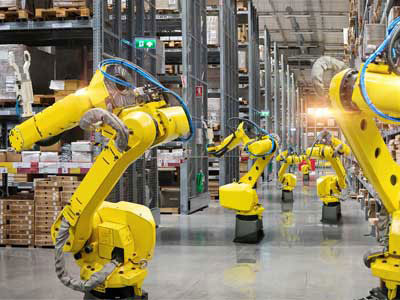Key Takeaway
The Automotive Industry uses the most robots. This industry has led the way in robot installations since 2010. According to the International Federation of Robotics (IFR), the automotive sector accounted for 28% of all robot installations by 2020. Robots in this industry perform tasks like welding, painting, and assembly. The extensive use of robots in automotive manufacturing boosts efficiency, ensures precision, and improves safety. As a result, the automotive industry remains the top user of industrial robots worldwide.
Automotive Industry
The automotive industry encompasses the design, production, and sale of vehicles, including cars, trucks, and motorcycles. It integrates advanced technologies in electronics, materials, and manufacturing processes to meet consumer demands for efficiency, safety, and performance. Key trends include electric and autonomous vehicles, sustainable practices, and digitalization of production and sales processes. As a crucial sector driving global economies, it continually evolves to balance innovation with regulatory standards and consumer preferences.

Electronics Manufacturing
In the dynamic world of electronics manufacturing, robots play a pivotal role in orchestrating the intricate dance of circuit board assembly and testing. Picture a high-tech facility where robotic arms delicately place minuscule components onto circuit boards with a precision measured in micrometers. This precision isn’t just for show; it underpins the reliability and functionality of everything from smartphones to sophisticated medical devices.
In electronics manufacturing, where every fraction of a millimeter matters, robotic systems excel in ensuring that soldering joints are flawless and testing procedures are rigorous. This level of automation isn’t just about speed and efficiency; it’s about guaranteeing that each gadget emerging from the production line meets stringent quality standards. Whether it’s ensuring the connectivity of microchips or the calibration of sensors, robots are the unsung heroes behind the scenes, ensuring that our modern gadgets work seamlessly from the moment they leave the factory.
Food and Beverage Processing
In the dynamic realm of food and beverage processing, robotics emerges as a pivotal force revolutionizing operations. These sophisticated machines are adept at handling a spectrum of tasks ranging from sorting and packing to palletizing, all while adhering to stringent hygiene standards critical for maintaining product safety. Imagine a bustling food processing plant where robots tirelessly maneuver through production lines, ensuring every product meets impeccable cleanliness protocols. Their precision in sorting ensures that only the highest quality ingredients move forward, while in packaging, they optimize efficiency, swiftly preparing products for distribution across global supply chains.
Robots are not just automatons; they are the sentinels of quality and efficiency in food processing. They navigate the complexities of modern production environments with dexterity, seamlessly integrating into existing systems to enhance throughput. This integration is crucial as it allows food processors to meet the escalating demands of global markets without compromising on safety or quality. From ensuring precise ingredient measurements to handling delicate packaging materials, robots in food processing exemplify the fusion of technology and industry expertise.
Pharmaceutical Production
In the exacting domain of pharmaceutical production, robotics plays a pivotal role in upholding the rigorous standards mandated by global regulatory bodies. These machines are at the forefront of ensuring the precise dispensing of medications and the sterile handling of sensitive pharmaceutical compounds. Picture a pharmaceutical facility where robots operate in sterile environments, meticulously packaging medications with utmost precision. Their role extends beyond mere automation; it encompasses safeguarding the integrity of pharmaceutical products, from the initial stages of production to final packaging.
The integration of robotics in pharmaceutical manufacturing heralds a new era of efficiency and safety. These machines operate with a level of accuracy that human hands alone cannot match, thereby reducing the margin for error in critical processes. They are designed not only to meet current regulatory requirements but also to anticipate future standards, ensuring that pharmaceutical companies stay ahead in an increasingly competitive market. By embracing robotics, pharmaceutical manufacturers enhance their capacity to produce medications at scale while maintaining the highest standards of safety and efficacy.
Heavy Industry
In heavy industries such as mining, construction, and metal fabrication, robotics plays a pivotal role in handling tasks that are physically demanding, dangerous, or require exceptional precision.
Heavy Lifting and Dangerous Tasks: Robots in heavy industries are designed to perform tasks that are beyond human capacity in terms of strength and endurance. For example, in mining operations, robotic systems are deployed for excavation and hauling of materials, tasks that involve lifting heavy loads over extended periods. By taking on these tasks, robots not only enhance productivity but also reduce the risk of workplace injuries associated with manual labor.
Enhanced Operational Efficiency: In environments where precision and accuracy are critical, such as metal fabrication and construction, robots excel in performing intricate operations like welding, cutting, and assembly. These tasks require high levels of precision to ensure the structural integrity and quality of finished products. Robots equipped with advanced sensors and computerized control systems can execute these operations with minimal margin for error, thereby improving overall operational efficiency and reducing production costs.
Conclusion
Industries at the forefront of robotics integration include manufacturing, automotive, electronics, and healthcare. These sectors leverage robotics for enhanced precision, efficiency, and safety across operations. In manufacturing, robots streamline assembly lines, while automotive relies on them for automation in production and logistics. Electronics benefit from robotic precision in assembly, and healthcare utilizes robots for surgeries and patient care. These industries continue to drive innovation, pushing the boundaries of robotics applications.
